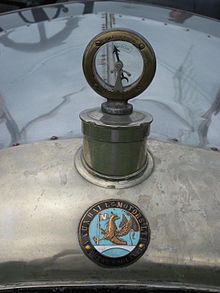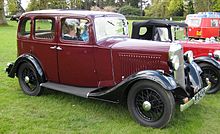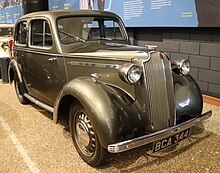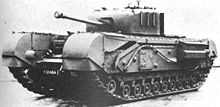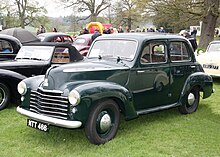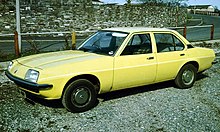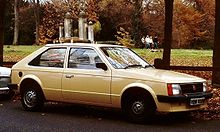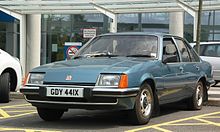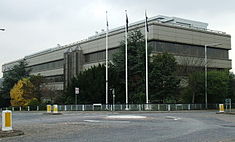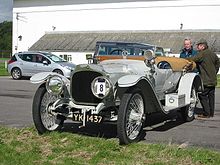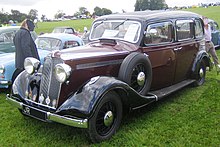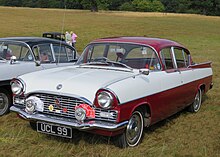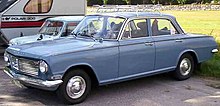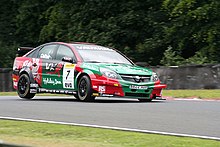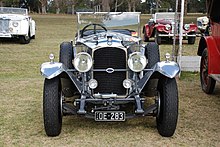Vauxhall Motors
[16] Pomeroy's first design, the Y-Type Y1, had outstanding success at the 1908 RAC and Scottish 2000 Mile Reliability Trials – showing excellent hill-climbing ability with an aggregate of 37 seconds less time in the hill climbs than any other car in its class.
During the First World War, Vauxhall made large numbers of the D-type, a Prince Henry chassis with derated engine, for use as staff cars for the British forces.
Modernisation and expansion of the Luton factory meant that the Light Six was sold for £195 for the standard four-door saloon, which was significantly less than many of its older rivals with four-cylinder engines and less interior appointments, and Vauxhall made the unusual decision to offer both 12 and 14 models for the same price.
The Light Six was an immediate sale success, surpassing all previous Vauxhall products by a large margin with 26,000 examples being sold in just over 12 months and with the Luton factory moving onto 24-hour shift work to meet demand.
The model was promoted as "The £1 Million Motor Car", reflecting the supposed investment in its design and production and was noted for its excellent fuel economy of over 40mpg when touring due to its efficient modern engine and lightweight body.
However the outbreak of the Second World War in 1939 greatly restricted the sales of all new cars just as the new Vauxhall range was entering the market and production was reaching full flow.
However Vauxhall's director of styling, David Jones, managed to fit brand new exterior panels to the front, rear and rear-quarters of the old body centre-section to give the L-type a modern look which shared its basic shape and features with GM's Chevrolet Fleetline of the same year, albeit at a much smaller scale.
Otherwise, the L-Types reused the three-speed transmission (albeit with a switch to a column gear change, hydraulic brakes and Dubonnet suspension of the pre-war models essentially unchanged.
GM was still restricting Vauxhall to a one-body policy and the range still consisted of two models differentiated mostly by their engines – the four-cylinder EIX Wyvern and the six-cylinder EIP Velox.
In terms of price and production the E-Type Vauxhalls were now full contenders in the mid-size car market in Britain, alongside the likes of the Ford Consul/Zephyr and especially the increasingly old-fashioned Hillman Minx.
Most importantly, Vauxhall returned to offering three car models (albeit all still sharing a single body design) with the addition of the Cresta, which was a more luxuriously styled and appointed version of the Velox.
The drivetrain was largely lifted from the outgoing E-Type Wyvern, but the engine received a higher compression ratio and updated carburation to account for the new widespread availability of high octane fuel and so made more power.
Stylistically the Victor followed the familiar Vauxhall trend of following American styling trends, although the Victor took this to a new level by closely resembling the famous 1955 Chevrolet Bel Air, complete with tailfins, prominent 'flutes' on the bonnet (a modern evocation of a familiar Vauxhall styling cue dating back to the 1920s), wrap-around front and rear screens, large chromed bumpers and an exhaust tailpipe integrated into one of the rear overriders.
With the Victor taking the place of many previous Wyvern sales, the P-Type models did not sell in the same quantities as the entire E-Type range had, but over 180,000 were built between October 1957 and July 1962 with over 100,000 of those cars being exported.
The F-Type Victor was especially badly affected by this issue, caused by a combination of thin-gauge steel to minimise weight, numerous moisture traps in its body design (for instance the hidden tailpipe design encouraged corrosive exhaust gases and condensation to collect in the rear wing corners), the fitting of a plasticised underseal treatment to the floorpan which served to trap moisture and dirt once it became chipped or cracked and the fact that the Victor was built in quantities and rates that the Luton plant had not previously dealt with.
Vauxhall's sales began to increase from 1975, with the launch of two important new models, the Chevette, a small three-door hatchback that was the first car of its kind to be built in Britain, and the Cavalier, a stylish four-door saloon designed to compete head-to-head with the all-conquering Ford Cortina.
This marked the end of a long and gradual process by GM to consolidate its two European subsidiaries with preference for the larger, and in terms of both absolute sales and market share, more successful Opel, which sold 925 000 vehicles to Vauxhall's 143 600.
[24] Since the early 1960s, Vauxhalls, whilst being designed and built in the United Kingdom, increasingly shared their general specification, engineering features, and styling with Opel counterparts (the Viva with the Kadett and the Victor with the Rekord, for instance) even if the two cars were distinct, with few to any interchangeable parts.
In 1978, Vauxhall strengthened its position in the executive car market with the launch of its all-new Carlton saloon and estate, which were facelifted versions of the German-built Opel Rekord.
The decade-old Nova was axed in 1993, in favour of the all-new Corsa, adopting the European naming of the model; its distinctive styling and practical interior began attracting more sales than its predecessor had done.
[49] It is reported that Astras produced at Ellesmere Port contain only 25% British parts, far below the typical 50 to 55% local content requirement Britain would have to agree to in bilateral trade deals.
The VXR badge was intended to be a symbol of the combined technological resources of the global General Motors group, and the recognised expertise of consultants Lotus and the Triple Eight Racing Team.
By this point, GM had begun to map out a shared platform strategy for Vauxhall, Opel and Holden, with four basic size classes - the S-body (supermini), T-body (sub-compact), U-body (extended subcompact), and V-body (executive).
Vauxhall had developed its own concept for the smaller S-body car which would have featured front-wheel drive, but for budgetary reasons the S-car project was abandoned and merged with the T-body project with the car emerging as the Vauxhall Chevette in 1975, essentially being the Opel Kadett C featuring 'Droopsnoot' styling (first prototyped on the HPF Firenza), but with an iteration of the hatchback body shell developed as part of the S-body studies.
The range topping V-body cars were the last to emerge in 1978, to replace the FE Victor, the first being the Carlton - essentially the Opel Rekord E, with a droopsnoot nose and lightly modified interior.
These were also sold in left hand drive in continental European markets, including the Netherlands,[57] Belgium, the Scandinavian countries, Italy and Portugal, in competition with their Opel counterparts.
However, this strategy was gradually abandoned – the Senator reverted to being badged as a Vauxhall for the 1985 model year, and the Opel Monza disappeared at the end of 1987, whilst the Manta was withdrawn in 1988.
The Opel-badged versions in right-hand drive form still however find their way into the United Kingdom; either as grey imports from Ireland or Malta, or are sold as new from car supermarkets who have sourced Irish specification vehicles in bulk.
[69] The griffin emblem, which is still in use, is derived from the coat of arms of Falkes de Breauté, a mercenary soldier who was granted the Manor of Luton for services to King John in the thirteenth century.
This was a much more serious contender, and in the hands of drivers such as Pentti Airikkala, Tony Pond, Russell Brookes and Jimmy McRae it and its successor version, the Chevette HSR, won many events in Britain and Europe.

